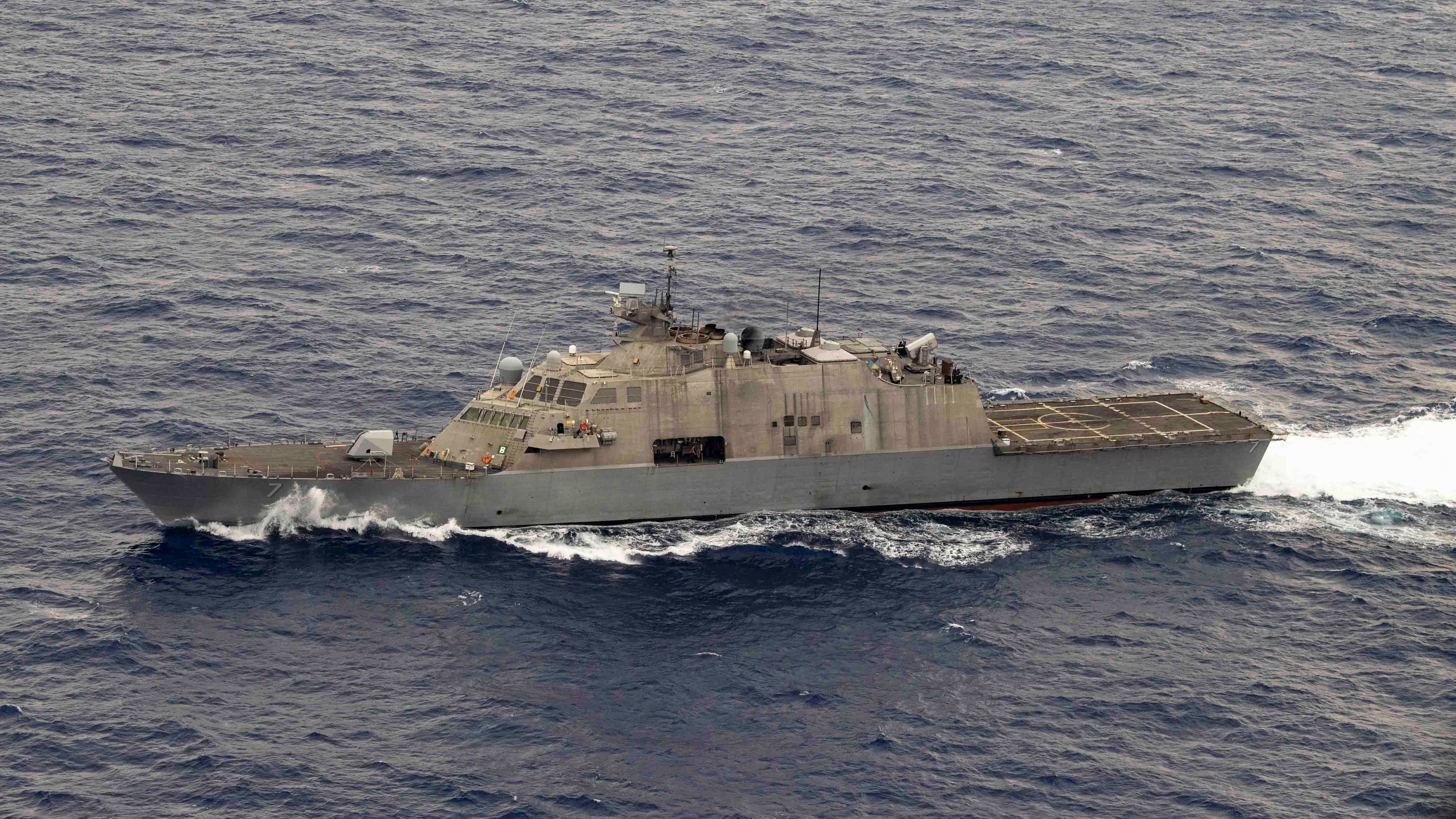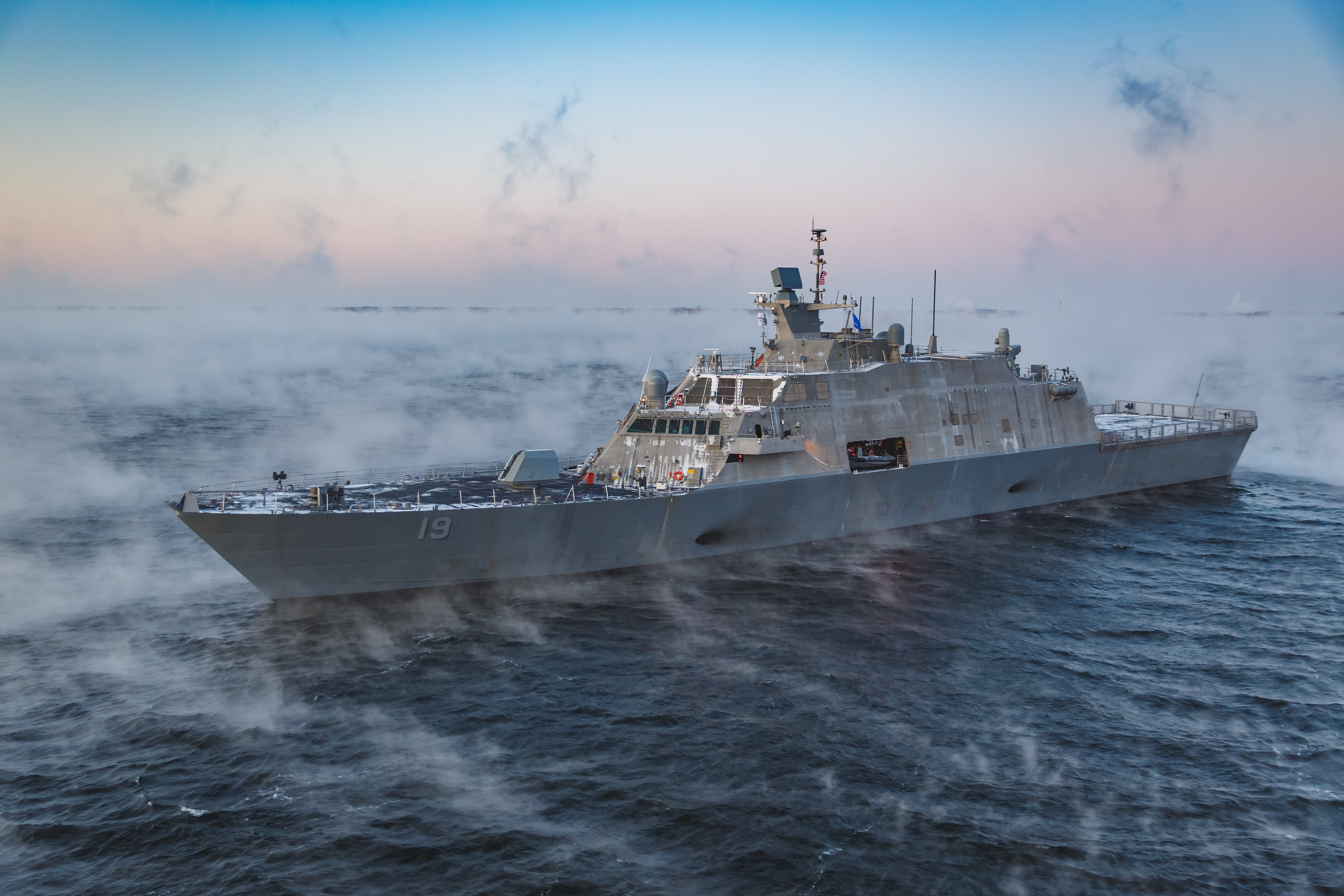WASHINGTON — Repeated failures in the propulsion train on the Freedom-class littoral combat ships Little Rock and Detroit have raised the specter of a class-wide design flaw that could trigger an expensive reworking of a crucial component on 17 of the Navy’s small surface combatants.
The issue being investigated is whether there is a fundamental issue with the design of the Freedom-class’ combining gear — a complex transmission that connects power from two large gas turbine engines and two main propulsion diesel engines to the ship’s propulsion shafts, which propel the ship through the water with water jets.
A potential class-wide issue with the propulsion train on 17 ships either in the fleet or under contract is the latest in a long string of issues with the littoral combat ship program. Senior Navy leaders have tried repeatedly to set the program aright only to be confronted with stubborn challenges ranging from unreliable engineering plants to glacial development progress on the sensor packages that would give the ships credible warfighting capabilities.
RELATED

The combining gear issue came to a head with repeated failures in recent months on the littoral combat ships Little Rock and Detroit, issues linked to the “high speed clutch bearings failing prematurely,” according to a statement from Naval Sea Systems Command.
Detroit’s combining gear suffered a casualty in October, forcing the ship to have to limp back to Florida. A subsequent power failure during the transit forced the ship to have to be towed into port.
In a statement, Naval Sea Systems Command said it was conducing a “root cause analysis” of the repeated breakdowns.
“The government is investigating a material defect with the combining gear of USS Detroit and USS Little Rock, both Freedom-variant littoral combat ships,” the statement reads. “A joint Navy and Lockheed Martin team with RENK AG, the original equipment manufacturer, are conducting a root cause analysis of this defect.”
But it’s beginning to look like a bigger problem.
The Navy is closing in on an assessment that the issue may need to be addressed across the class, the statement reads, an issue that experts have told Defense News would be difficult and costly. In the meantime, the in-service ships are limiting the use of its combining gear, which limits ships specifically designed for speed to operating at around 10 knots.
“Based upon preliminary assessments, the defect appears to be a design issue that will need to be addressed across the Freedom class,” the statement reads. “The Navy is taking the final steps to verify this as part of the root cause analysis of the combining gear failures. While this is in progress, measures have been implemented to mitigate risk to all the in-service Freedom variant ships.”
The Freedom-class was designed by Lockheed Martin and built at Fincantieri’s Marinette Marine shipyard, which recently won the Navy’s next-generation frigate competition. There are 10 Freedoms in service today, with an additional seven either under construction or under contract, according to the Navy’s 2021 budget justification books.
In a statement, a Lockheed Martin spokesperson said it was committed to fixing the combining gear problem.
“In partnership with the U.S. Navy, Lockheed Martin is aggressively pursuing a resolution to the gear issue the Freedom-variant littoral combat ship is currently experiencing,” the statement read.

The Independence-class littoral combat ship, a trimaran aluminum hull ship built at Austal USA in Mobile, Alabama, has a different propulsion train from the Freedom-class and thus would not be affected by this issue.
The Freedom-class combining gear was an imperfect solution engineered to meet a demanding 40-knot-plus speed requirement.
With just its diesel engines engaged, the ship can make between 10 and 12 knots, but to go any faster it must engage the gas turbine engines. The combining gear fuses and transmits the power to the propulsion shafts. It is a system with a lot of moving parts and has proven unreliable.
The issues date back to at least late 2015, when the LCS Milwaukee broke down on its maiden voyage to its home port in Mayport, Florida, and had to be towed into Little Creek amphibious base in Hampton Roads, Virginia. Early the next year, the littoral combat ship Fort Worth suffered a casualty to the combining gear in port when sailors accidentally ran the system without lube oil running through it.
A tricky problem
Fixing a design flaw with the combining gear across the whole class is no easy fix, according to sources and experts who spoke to Defense News.
The Navy is still assessing what such a fix would cost and who would be on the hook to pay for it, according NAVSEA’s statement, but no matter who is ultimately responsible it would require repairs to a system that was supposed to last the life of the hull, said Matthew Collette, associate professor of naval architecture and marine engineering at University of Michigan.
There is nothing inherently wrong with combined diesel and gas propulsion trains, Collette said, but the 40-knot speed requirement might be just on the edge of what’s possible from the system.
“It’s something that should work,” Collette said. “But it’s like everything else on LCS: It was driven by the speed requirement. Because the diesels are about 20 percent of the power of the gas turbine, you don’t want to leave them out when you’re trying to hit that sprint speed. It’s such a demanding requirement.
“So, it is not a technology that strikes me as inherently problematic. But like a lot of the LCS decisions, we were kind of trying to get every last ounce of performance out of the vessel. And you stack up a whole bunch of those decisions that the ship is not as reliable as you would like.”
Getting after the issue now, after the ship has already been designed and fielded is anything but simple, Colette continued.
“Fixing LCS now is a huge problem, because we generally don’t design gearboxes to be replaced during the ship’s service life,” he said. “Could you switch it out with an either/or gearbox instead of an combining gearbox? I mean, I think you can on the whiteboard and it would drop the top speed a little, but we’re trying to improve the reliability. I’m not sure you could do that in the confines of the ship, however.”
Still, the root cause analysis could turn up something relatively simple to fix any potential flaws in the system, Collette said.
“Without the details of how the gears are failing, it’s much harder to say how easy it is going to be to fix this,” he said. “If it’s filters, or the lube oil system is not strong enough for certain operating conditions? You could upgrade those parts of the gearbox. If there’s a fundamental design flaw, then it gets much harder to figure out how you’re going to fix this issue cost effectively.”

‘On my watch’
The issues with LCS reliability are not lost on the Navy’s senior leaders.
In a July interview with Defense News, Chief of Naval Operations Adm. Michael Gilday said he was committed to addressing the reliability issues with the platform.
“There are things in the near term that I have to deliver, that I’m putting heat on now, and one of them is LCS,” Gilday said. “One part is sustainability and reliability. We know enough about that platform and the problems that we have that plague us with regard to reliability and sustainability, and I need them resolved.
“That requires a campaign plan to get after it and have it reviewed by me frequently enough so that I can be sighted on it. Those platforms have been around since 2008 — we need to get on with it. We’ve done five deployments since I’ve been on the job, we’re going to ramp that up two-and-a-half times over the next couple of years, but we have got to get after it,” he added. “LCS for me is something, on my watch, I’ve got to get right.”
For Gilday, the continued reliability issues on LCS are a lesson the Navy needs to learn as it pushes forward with new classes of ships and unmanned surface vessels as part of a push to grow the Navy, he told Defense News.
“I go back to: Do I really need a littoral combat ship to go 40 knots?” Gilday mused. “That’s going to drive the entire design of the ship, not just the engineering plant but how it’s built. That becomes a critical factor. So, if you take your eye off the ball with respect to requirements, you can find yourself drifting.”
David B. Larter was the naval warfare reporter for Defense News.




